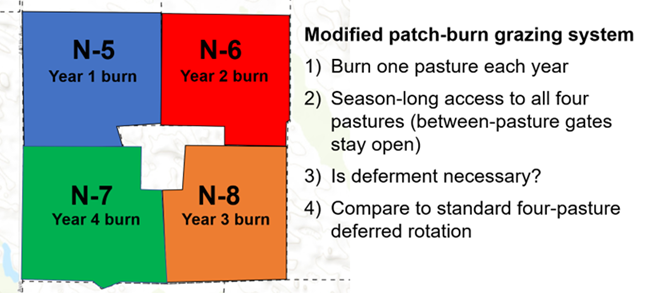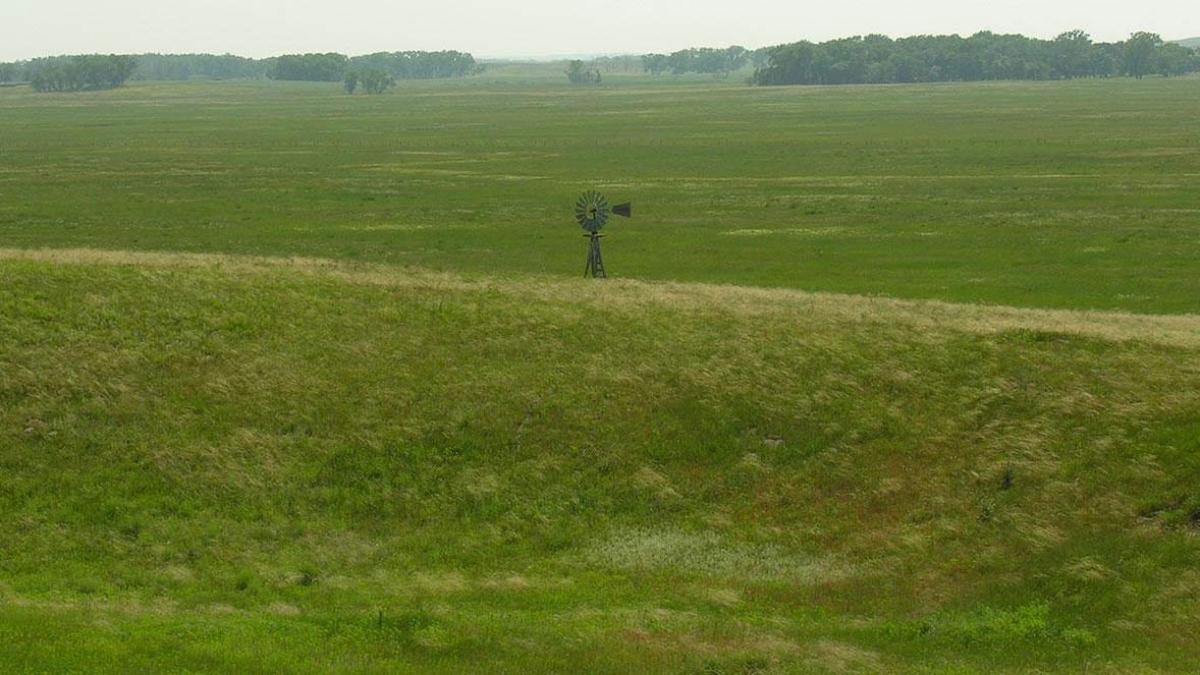Barta Brothers Ranch is located about 20 miles south of Long Pine in Rock and Brown Counties in Nebraska.
This article was first published March 3, 2023, as part of the Department of Agricultural Economics series, Cornhusker Economics.
In 2020, the University of Nebraska’s Barta Brothers Ranch (BBR) launched a collaborative adaptive management (CAM) project to address risks and uncertainties related to grassland management in the Sandhills. The project brings together UNL faculty engaged in research, extension, and teaching across multiple disciples, departments, and geographic locations. All three IANR District Research, Extension, and Education Centers are involved in the project (Eastern Nebraska, Panhandle, and West Central) along with three East Campus-based centers: the Center for Grassland Studies, the Center for Resilience in Agricultural Working Landscapes, and the Center for Agricultural Profitability housed in the Department of Agricultural Economics.
The project, which receives funding support from the Nebraska Environmental Trust and the North Central Region Sustainable Agriculture Research and Education grant programs, focuses on evaluating stakeholder-designed management plans implemented on the Barta Brothers Ranch in a collaborative research setting. This emphasis on co-producing science ensures CAM reflects real-world ranching conditions of the Sandhills and the north-central Great Plains.
Who are our collaborators?
Deciding on the objectives and establishing context is critical to any management approach. This is especially challenging in agriculture where management of the natural resource, animal, human, social, and business systems are complex and characterized by multiple sources of uncertainty. While a team approach is helpful in managing this complexity, it brings with it its own challenges, particularly with diverse stakeholders. The BBR CAM project brings together four eastern Sandhills ranchers along with representatives from the Nebraska Game and Parks Commission, Nebraska Forest Service, Natural Resources Conservation Service, US Fish and Wildlife Service, The Nature Conservancy, and the Sandhills Task Force to form a stakeholder group. It is discussions and shared information among this diverse group of stakeholders that drives the BBR CAM project.
How does CAM work?
Over a series of meetings held at the BBR, the project team engaged with the stakeholder group to implement a “collaborative adaptive management” framework for addressing challenges in rangeland management. This type of approach incorporates an iterative, structured decision-making process where problems, solutions, and outcomes are identified and continually assessed over time. In the first phase, ranching challenges were identified followed by the establishment of management objectives (Table 1).
| Woody encroachment and invasive species management | Plant heterogeneity/diversity |
| Economic and ecological tradeoffs of management | Landscape multifunctionality |
| Capabilities of mulit-species grazing | Issues related to climate change |
These were re-formulated into the following objectives for the BBR CAM project management practices in year 1:
(1) Reduce woody encroachment.
(2) Increase heterogeneity on the landscape.
(3) Improve livestock production.
In the second phase, the BBR CAM project team and stakeholders discussed various management actions that could be studied to bring about the desired results described in the three objectives. It was decided to adopt a burn/grazing strategy as the first management action. Subsequently, evaluation criteria were identified for each of the objectives along with measurement and monitoring plans. The burn/graze management action was implemented in 2022 and preliminary results are now emerging.
Management Action and Monitoring
The management action in the spring of 2022 was to burn pasture N-5 that has typically been managed as part of a traditional four-pasture rotation (Figure 1). Instead of a closed-gate rotation through the four pastures during the grazing season, the gates were left open and open grazing by spayed heifers was allowed throughout the section. Researchers targeted livestock behavior, heterogeneity/diversity (e.g., species composition of vegetation and birds), and livestock performance (e.g., weight gain) for evaluation. Below are the preliminary results and discussions of the implications.
Figure 1. Management Action on Barta Brothers Ranch Collaborative Adaptive Management project.

Livestock Behavior
The boost in nutrient value of grasses and forbs due to prescribed burning is well documented in rangeland research. Fire helps remove standing dead plant material buildup, which increases access to a more nutritious diet for grazing animals. As a result, cattle will focus grazing on burned sites and reduce grazing pressure on unburned areas of the pastures. As the grazing season goes on, animals will spread out to other areas of the pasture but still return periodically to selectively graze certain species in the burned patches within the pasture. GPS tracking collars were placed on a portion of the study animals to evaluate shifts in cattle grazing behavior (i.e., grazing and resting times) and grazing distribution (i.e., where animals are grazing) in the study pastures. Our first-year results aligned with previous studies with cattle spending 1.5 to 2 times more time in the burned patches compared to unburned areas within the pastures.
Annual Plant Production
Developing a better understanding of how burning and grazing effects vegetation growth over time is a key outcome of the BBR CAM project’s research. In 2022, plant samples were collected in the burned area of the study and compared to Barta Brother’s Ranch long-term grazing systems data which has evaluated plant production for over 20 years. At this point data is still being analyzed and multiple years of data are needed to draw conclusions, but there was no difference in the total annual plant production on the burned compared to unburned pastures. The main difference between the burned and unburned areas was the amount of standing dead and litter plant material.
Livestock Performance
The animals were weighed three times during the year, pre-turnout in May, mid-season in July, and before pull-off in late-September. As a control, heifers grazing in the management pastures N-5 through N-8 were compared to other spayed heifers in a standard 4-pasture deferred rotation system that has been commonly used at the Barta Brothers Ranch. At the end of the grazing season in 2022, cattle in the burn/graze system management system were 43 lbs. heavier than those in the standard deferred system (Figure 2). These gains were not consistent throughout the grazing season, the cattle in the burn/graze system tended to gain more weight in June & July, but later tracked closely with weight gains of the animals in the standard deferred rotation over the last two months. At the market the heifers were sold at in 2022, cattle in the burned/grazed system returned an additional $86.96 per head. Of course, this is based on one-year of data in a relatively high cattle price scenario.
Figure 2. Animals in the burn/graze management system were 43 lbs. heavier at time of sale with most of this difference in performance occurring in the first two months.

Work Continues
The stakeholders of the BBR CAM project were encouraged by the first-year results and recommended continuation with the plans to burn pasture N-6 in the spring of 2023, followed by season-long grazing across all four pastures. The results from the first year of weight gains and livestock movement data help validate the project’s working hypothesis that burn/graze systems can increase livestock performance and rancher profitability while controlling invasive eastern red cedar encroachment into the pastures. Measurement continues of plant biodiversity, soil erosion, bird populations, and other factors contributing to the desired outcome of a more resilient landscape. The effect of burning and grazing on long-term plant performance and rangeland health will also continue to be tracked.
This work is supported by funding from the Nebraska Environmental Trust and the North Central Region Sustainable Agriculture Research and Education grant program.
Jay Parsons, Professor
Farm and Ranch Management Specialist
Center for Agricultural Profitability
Department of Agricultural Economics
University of Nebraska-Lincoln
Mitchell Stephenson, Associate Professor
Range and Forage Specialist
Panhandle Research and Extension Center
Department of Agronomy & Horticulture
University of Nebraska-Lincoln
Kyle Martens, Program Coordinator II
Gwendwr Meredith, Assistant Professor
Dan Uden, Assistant Professor
Center for Resilience in Agricultural Working Landscapes
School of Natural Resources
Department of Agronomy and Horticulture
